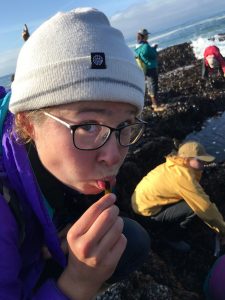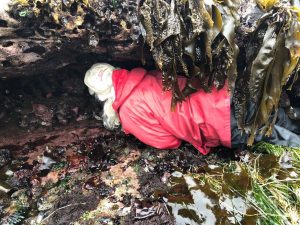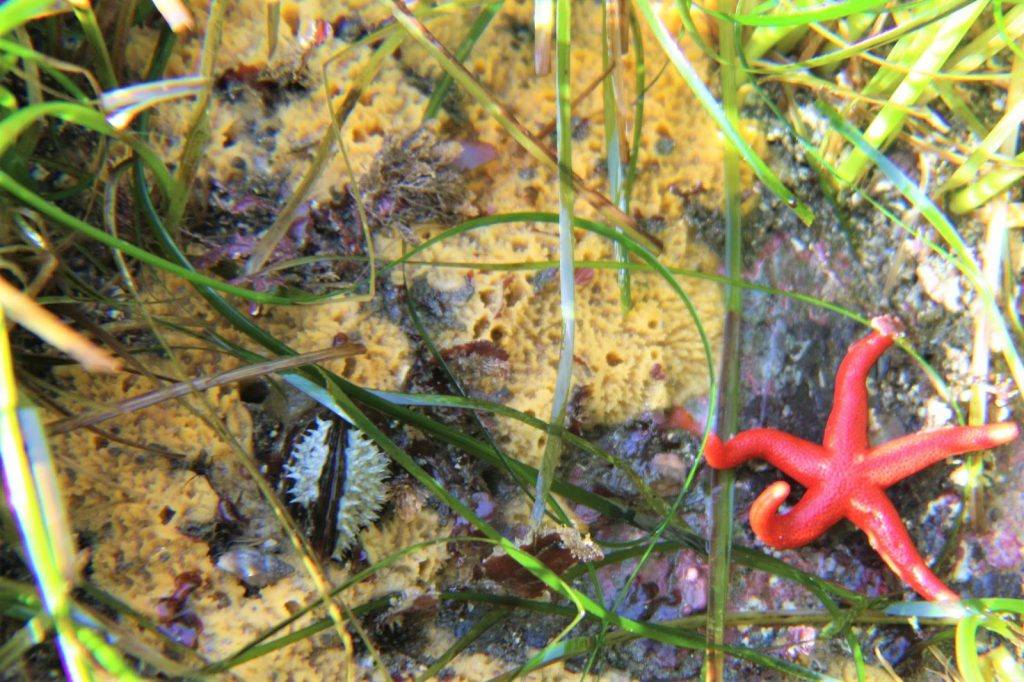From the autumn 2019 Sea Star print newsletter
By Helen Kesting, guest student writer

The author tasting a piece of seaweed. It was surprisingly spicy! Photo: Sanna Titus
Just 50 miles away from Seattle as the crow flies, the University of Washington runs a marine field station on San Juan Island called Friday Harbor Laboratories (FHL). Wooden buildings, grass fields and grazing deer cover the campus, which is surrounded by nearly 400 acres of mixed coniferous forest. During the weekends, students entertain themselves by hiking or by taking a rowboat to a nearby cove. At night, you might find a dozen or so people huddled out on the docks watching fish swim around a bright dive light: an activity known as “FHL TV.”
Last spring quarter, I lived and studied at FHL as a student in the Zoology-Botany (or “Zoo-Bot”) program. My 16 classmates and I packed our schedule from 8:30 a.m. to 5:00 p.m. with lectures, labs and field trips led by inspirational professors who shared an infectious passion for their respective fields. Our professors were also esteemed research scientists. Washington Sea Grant (WSG) is proud to have supported some of their work.
One of our professors was Megan Dethier, who is currently serving as FHL’s Interim Director. In recent years, Dethier received funding from WSG for her research on the factors affecting juvenile clam mortality as well as the ecological impacts of shoreline armoring. She helped me understand the diverse ecological roles occupied by invertebrates in 13 different phyla. Dethier is clearly passionate about her work: “It is gratifying to find that even in this modern era with its different demands on students’ time, there is still appeal in courses that get students connected to live plants and animals and their habitats, and doing research about those organisms,” she said.
Thanks to a system of pumps and pipes that circulate water from the Puget Sound, we could bring our field trip collections back to the labs and keep them in conditions that mimic the environment. Our seawater tanks were always full of crabs, anemones, nudibranchs, sea stars and other marine creatures, which we could observe at any time. One tank even had a bright magenta scale worm, which was nearly a foot long and only left its glass bottle home at night.
Though the diversity of biota on San Juan Island was stunning, it paled in comparison to what we saw on our final field trip. During the last week of classes, we packed our camping gear and traveled to Vancouver Island, B.C., to spend three nights at Port Renfrew, just south of the famous West Coast Trail. We spent two days at Botanical Beach Provincial Park, where unique geologic features and unparalleled biological diversity create a place of otherworldly appearance.

Professor Megan Dethier crawls under a rock formation to get a closer look at the invertebrate diversity at Botanical Beach on Vancouver Island, B.C. Photo: Ryu Kawada
One of the requirements of the Zoo-Bot program is completing an independent research project. Each one of us formulated a question, designed an experiment, and carried out the experiment in under two weeks. We presented our findings via an oral presentation, as well as a scientific paper. My classmates studied development and behavior in larvae of diverse marine organisms, such as bull kelp (Nereocystis leutkeana), sand dollars (Dendraster excentricus) and kelp crabs (Pugettia producta).
For several of my classmates, this was the first research project of many more to come— perhaps one of them may even receive funding from WSG someday. The experiences my fellow students and I gained at FHL will benefit us throughout our careers as we work to understand our oceans and protect them into the future.

NOV
2019